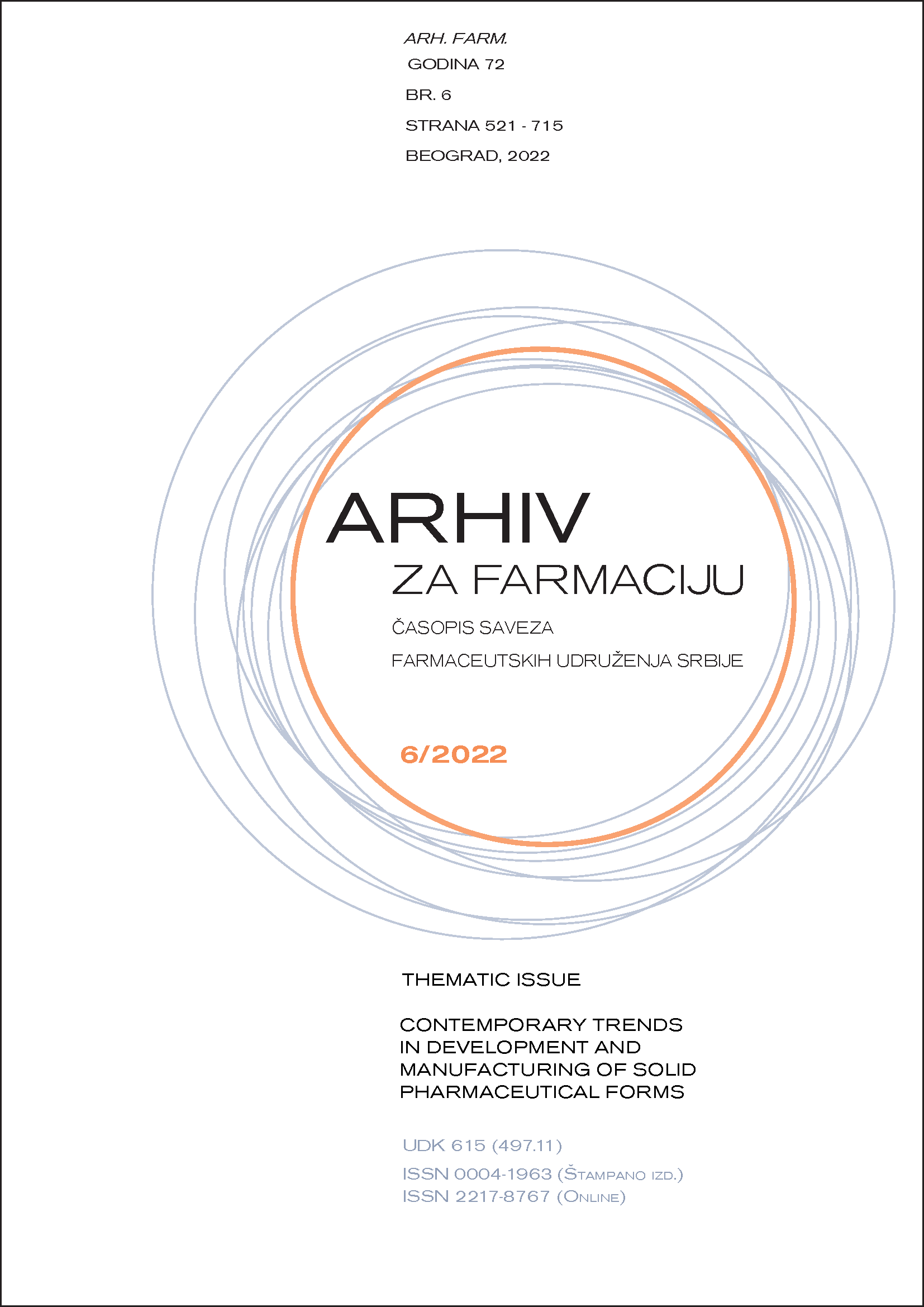Usage of compaction simulators for the powder compression characterization – advantages and limitations
Abstract
Compaction simulators are designed as machines which can provide an in-depth analysis of the powder compaction process. Characterization of the powder compression and compaction process, as well as material characterization, play an important role in the formulation and manufacturing process design and development, as well as in creating a strong knowledge basis for the scale-up of the tablet compression and troubleshooting in further stages of the product lifecycle. Although compaction simulators are designed to simulate the compression process on high-speed tablet-presses, with the advantages of a small quantity of material needed and highly sophisticated instrumentation, there are certain limitations in the extrapolation of the process parameters from these machines to high-speed rotary tablet presses. However, the advantage of the use of compaction simulators for studying basic compression and compaction mechanisms, identification of critical material attributes and critical process parameters ranges, and their relations with tablet characteristics and critical quality attributes of pharmaceutical products is clear, compared to the use of small excentre tablet presses, and complementary to the use of small rotary tablet presses. This scientific paper provides an overview and examples of the different advantages provided by the instrumentation of compaction simulators, including certain limitations in their exploitation.
References
1. Tableting specification manual. 7th ed, American Pharmacists Association, 2006.
2. Natoli D, Levin M, Tsygan L, Liu L. Development, optimization and scale-up of process parameters: tablet compression. In: Qiu Y, Chen Y, Zhang G. 1st edition,
Developing Solid Oral Dosage Forms pharmaceutical theory and practice. Academic press Elsevier: 2009; p. 725-760
3. Hiestand EN. Principles, tenets and notions of tablet bonding and measurements of strength. Eur J Pharm Biopharm. 1997;44:229–242.
4. Van der Voort Maarschalk K. Tablet relaxation, origin and consequences of stress relief in tablet formation [dissertation]. [Groningen]: Riksuniversiteit Groningen; 1997. 141 p.
5. Muñoz-Ruiz A, Jimenez-Castellanos MR, Cunningham JC, Katdare AV. Theoretical estimation of dwell and consolidation times in rotary tablet machines. Drug Dev Ind Pharm. 1992;18(9):2011–28.
6. Çelik M, Marshall K. Use of a compaction simulator system in tableting research. Drug Dev Ind Pharm. 1989;15(5):759–800.
7. Bateman SD. A comparative investigation of compression simulators. Int J Pharm. 1989;49:209–212.
8. Rubinstein MH. Compaction properties of a cellulose – lactose direct-compression excipient. Pharm Tech. 1991;4:76–80.
9. Celik M, Ong JTH, Chowhan ZT, Samuel GJ. Compaction simulator studies of a new drug substance: effect of particle size and shape, and its binary mixtures with microcrystalline cellulose. Pharm Dev Tech. 1996;1:119–126.
10. Nokhodchi A, Rubinstein MH. Compaction simulators in tableting research. Pharm Tech Suppl – Tab Gran Yearbook. 1996;6:18.
11. Tardy G. Analis SoftwareTM User guide of software Analis, Rev. B. Medelpharm 2012.
12. Levin M. Tablet press instrumentation. New York, USA: Marcel Dekker; 2002.
13. Von Schmidt PC, Tenter U. Displacement Measurements of Rotary Presses. Pharm Ind. 1985;47:426–430.
14. Nikolic N. Application of quality by design concept for identification, qualification and modeling of critical quality attributes of modified release tramadol-hydrochloride matrix tablets [dissertation]. [Belgrade]: University in Belgrade; 2015.
15. Mazel V, Desbois L, Tchoreloff P. Influence of the unloading conditions on capping and lamination: Study on a compaction simulator, Int J Pharm. 2019;567:118468.
16. Tye CK, Sun CC, Amidon GE. Evaluation of the effects of tableting speed on the relationships between compaction pressure, tablet tensile strength, and tablet solid fraction. J Pharm Sci. 2005;94(3):465–472.
17. Çelik M. Pharmaceutical powder compaction technology. Florida, USA: CRC Press; 2016.
18. Busignies V, Mazel V, Diarra H, Tchoreloff P. Prediction of the compressibility of complex mixtures of pharmaceutical powders. Int J Pharm. 2012;436(1-2):862-8.
19. Michaut F, Busignies V, Fouquereau C, Barochez BHD, Leclerc B, Tchorelo P. Evaluation of a rotary tablet press simulator as a tool for the characterization of compaction properties of pharmaceutical products. J Pharm Sci. 2010;99:2874–2885.
20. Picker KM. A new theoretical model to characterize the densification behavior of tableting materials. Eur J Pharm Biopharm. 2000;49(3):267–273.
21. Heckel RW. Density – pressure relationships in powder compaction. Trans Metall Soc AIME. 1961;221:671–675.
22. Ruegger CE, Celik M, Advanced compaction research equipment: compaction simulators. In: Celik M, 2nd edition, Pharmaceutical Powder Compaction Technology, CRC Press, p. 99–128.
23. Ozalp Y, Chunu JT, Jiwa N. Investigation of the compressibility characteristics of paracetamol using "compaction simulator". Turk J Pharm Sci. 2020;17(3):249-254.
24. Ilić I, Govedarica B, Šibanc R, Dreu R, Srčič S. Deformation properties of pharmaceutical excipients determined using an in-die and out-die method. Int J Pharm. 2013;446:6–15.
25. Sun C, Grant DJ. Influence of elastic deformation of particles on Heckel analysis. Pharm Dev Technol. 2001;6(2):193–200.
26. Amidon GE, Secreast PJ, Mudie D. Particle, Powder, and Compact Characterization In: Qiu Y, Chen Y, Zhang G. 1st edition,
Developing Solid Oral Dosage Forms pharmaceutical theory and practice. Academic press Elsevier: 2009; p. 163-186
27. Imayoshi Y, Ohsaki S, Nakamura H, Watano S. Continuous measurement of die wall pressure in a rotary tablet machine. Int J Pharm. 2022;627(11):122251.
28. Abdel-Hamid S, Betz G. Investigating the effect of punch geometry on high speed tableting through radial die-wall pressure monitoring. Pharm Dev Technol. 2013;18(1):46-54.
29. Guntermann A. Untersuchung der Tablettier Simulation mit dem PressterTM in Abhängigkeit von der Formulierung, Chargengrösse und der Tablettenpresse [dissertation]. [Basel]: University of Basel; 2008.
30. Thorsten N. Investigation and optimization of the Presster – a linear compaction simulator for rotary tablet presses [dissertation]. [Bonn]: University of Bonn; 2007.
31. Wünsch I, Friesen I, Puckhaber D, Schlegel T, Finke JH. Scaling tableting processes from compaction simulator to rotary presses - mind the sub-processes. Pharmaceutics. 2020;12:310.

